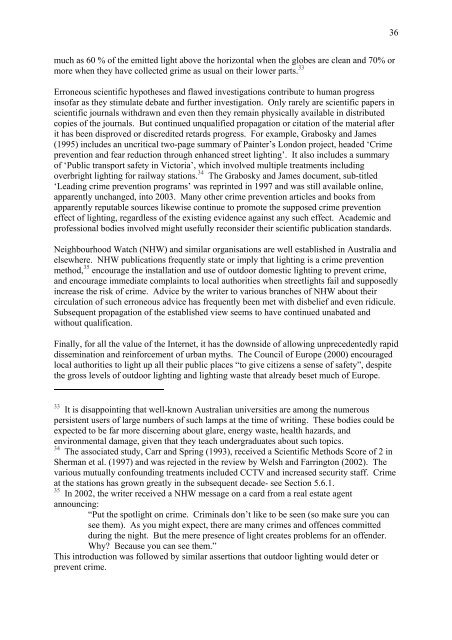Outdoor Lighting and Crime - Amper
Outdoor Lighting and Crime - Amper
Outdoor Lighting and Crime - Amper
You also want an ePaper? Increase the reach of your titles
YUMPU automatically turns print PDFs into web optimized ePapers that Google loves.
much as 60 % of the emitted light above the horizontal when the globes are clean <strong>and</strong> 70% or<br />
more when they have collected grime as usual on their lower parts. 33<br />
Erroneous scientific hypotheses <strong>and</strong> flawed investigations contribute to human progress<br />
insofar as they stimulate debate <strong>and</strong> further investigation. Only rarely are scientific papers in<br />
scientific journals withdrawn <strong>and</strong> even then they remain physically available in distributed<br />
copies of the journals. But continued unqualified propagation or citation of the material after<br />
it has been disproved or discredited retards progress. For example, Grabosky <strong>and</strong> James<br />
(1995) includes an uncritical two-page summary of Painter’s London project, headed ‘<strong>Crime</strong><br />
prevention <strong>and</strong> fear reduction through enhanced street lighting’. It also includes a summary<br />
of ‘Public transport safety in Victoria’, which involved multiple treatments including<br />
overbright lighting for railway stations. 34 The Grabosky <strong>and</strong> James document, sub-titled<br />
‘Leading crime prevention programs’ was reprinted in 1997 <strong>and</strong> was still available online,<br />
apparently unchanged, into 2003. Many other crime prevention articles <strong>and</strong> books from<br />
apparently reputable sources likewise continue to promote the supposed crime prevention<br />
effect of lighting, regardless of the existing evidence against any such effect. Academic <strong>and</strong><br />
professional bodies involved might usefully reconsider their scientific publication st<strong>and</strong>ards.<br />
Neighbourhood Watch (NHW) <strong>and</strong> similar organisations are well established in Australia <strong>and</strong><br />
elsewhere. NHW publications frequently state or imply that lighting is a crime prevention<br />
method, 35 encourage the installation <strong>and</strong> use of outdoor domestic lighting to prevent crime,<br />
<strong>and</strong> encourage immediate complaints to local authorities when streetlights fail <strong>and</strong> supposedly<br />
increase the risk of crime. Advice by the writer to various branches of NHW about their<br />
circulation of such erroneous advice has frequently been met with disbelief <strong>and</strong> even ridicule.<br />
Subsequent propagation of the established view seems to have continued unabated <strong>and</strong><br />
without qualification.<br />
Finally, for all the value of the Internet, it has the downside of allowing unprecedentedly rapid<br />
dissemination <strong>and</strong> reinforcement of urban myths. The Council of Europe (2000) encouraged<br />
local authorities to light up all their public places “to give citizens a sense of safety”, despite<br />
the gross levels of outdoor lighting <strong>and</strong> lighting waste that already beset much of Europe.<br />
33<br />
It is disappointing that well-known Australian universities are among the numerous<br />
persistent users of large numbers of such lamps at the time of writing. These bodies could be<br />
expected to be far more discerning about glare, energy waste, health hazards, <strong>and</strong><br />
environmental damage, given that they teach undergraduates about such topics.<br />
34<br />
The associated study, Carr <strong>and</strong> Spring (1993), received a Scientific Methods Score of 2 in<br />
Sherman et al. (1997) <strong>and</strong> was rejected in the review by Welsh <strong>and</strong> Farrington (2002). The<br />
various mutually confounding treatments included CCTV <strong>and</strong> increased security staff. <strong>Crime</strong><br />
at the stations has grown greatly in the subsequent decade- see Section 5.6.1.<br />
35<br />
In 2002, the writer received a NHW message on a card from a real estate agent<br />
announcing:<br />
“Put the spotlight on crime. Criminals don’t like to be seen (so make sure you can<br />
see them). As you might expect, there are many crimes <strong>and</strong> offences committed<br />
during the night. But the mere presence of light creates problems for an offender.<br />
Why? Because you can see them.”<br />
This introduction was followed by similar assertions that outdoor lighting would deter or<br />
prevent crime.<br />
36
















